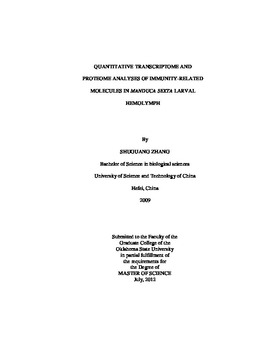| dc.contributor.author | Zhang, Shuguang | |
| dc.date.accessioned | 2014-04-15T19:06:30Z | |
| dc.date.available | 2014-04-15T19:06:30Z | |
| dc.date.issued | 2012-07-01 | |
| dc.identifier.uri | https://hdl.handle.net/11244/8650 | |
| dc.description.abstract | This study explores immunity-related molecules in Manduca sexta larvae by studying the quantitative change of mRNAs and proteins after immune challenge. To investigate the mRNA level changes, we isolated mRNA samples from fat body and hemocytes of both pathogen- and buffer-injected insects. The cDNA samples were separately sequenced on 454 pyrosequencer. Short reads from different samples were assembled to contigs and read numbers from each sample were retrieved for all the contigs. These numbers were used to calculate relative abundances of the corresponding genes in each sample. Thus we compared the read numbers from different samples and found immune induced/suppressed genes and tissue preferentially expressed genes. In the proteome study, we collected plasma from both pathogen- and buffer-injected insects. After gel electrophoresis or acetonitrile precipitation, plasma samples were digested by trypsin and subsequently analyzed on mass analyzer. A manually constructed protein database was used for protein identification and spectral counts for each protein were used for semi-quantitative analysis. In the transcriptome study, we obtained two millions of reads which were assembled to 19,020 contigs. By comparing read numbers from different samples we found 528 up-regulated genes including different immune factors. We also found hundreds of down-regulated genes and fat body/hemocyte preferentially expressed genes. The set of genes enlarged our knowledge about immune factors in M. sexta. They also contributed to the M. sexta genome annotation. In the proteome study, we identified 785 proteins from the gel-extracted samples and 270 samples from the acetonitrile treated samples. Of them, 115 and 155 proteins were found to be increased and decreased after immune challenge, respectively. A total of 211 immunity-related proteins were discovered in this study. The transcriptome study showed the efficiency and accuracy of pyrosequencing in quantitative transcriptomic analyses. The proteome study proved the robustness of spectral counting method. These two studies showed that many immune factors did not show drastic change except that antimicrobial peptides were highly induce at both mRNA and protein levels. | |
| dc.format | application/pdf | |
| dc.language | en_US | |
| dc.publisher | Oklahoma State University | |
| dc.rights | Copyright is held by the author who has granted the Oklahoma State University Library the non-exclusive right to share this material in its institutional repository. Contact Digital Library Services at lib-dls@okstate.edu or 405-744-9161 for the permission policy on the use, reproduction or distribution of this material. | |
| dc.title | Quantitative Transcriptome and Proteome Analyses of Immunity-related Molecules in Manduca Sexta Larval Hemolymph | |
| dc.type | text | |
| osu.filename | Zhang_okstate_0664M_12287.pdf | |
| osu.college | Agricultural Sciences and Natural Resources | |
| osu.accesstype | Open Access | |
| dc.description.department | Department of Entomology and Plant Pathology | |
| dc.type.genre | Thesis | |
| dc.subject.keywords | insect immunity | |
| dc.subject.keywords | manduca sexta | |
| dc.subject.keywords | proteomics | |
| dc.subject.keywords | pyrosequencing | |
| dc.subject.keywords | quantitative analysis | |
| dc.subject.keywords | transcriptomics | |
